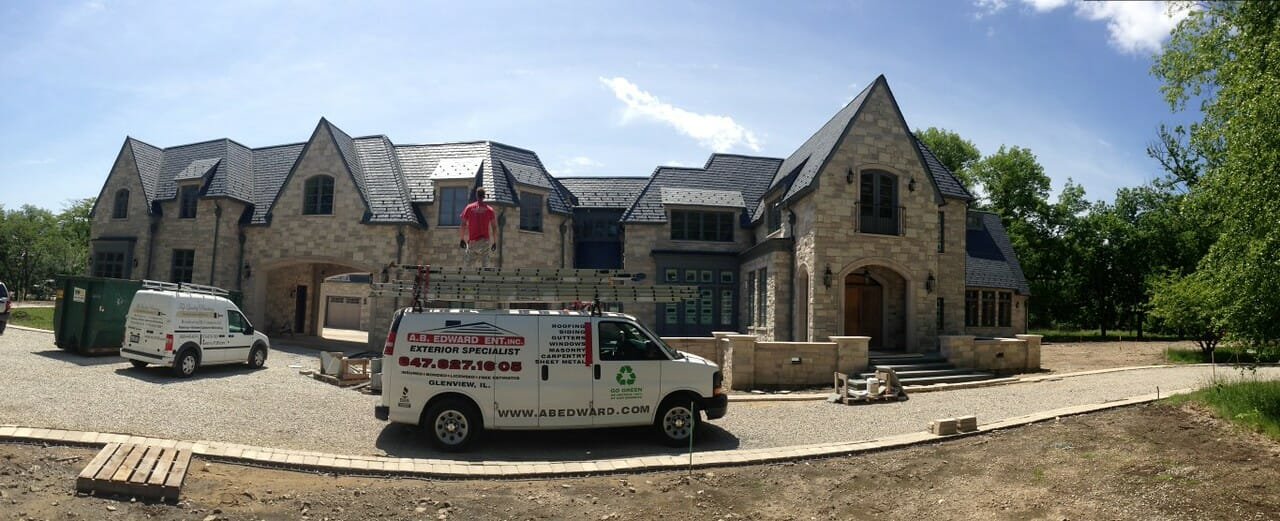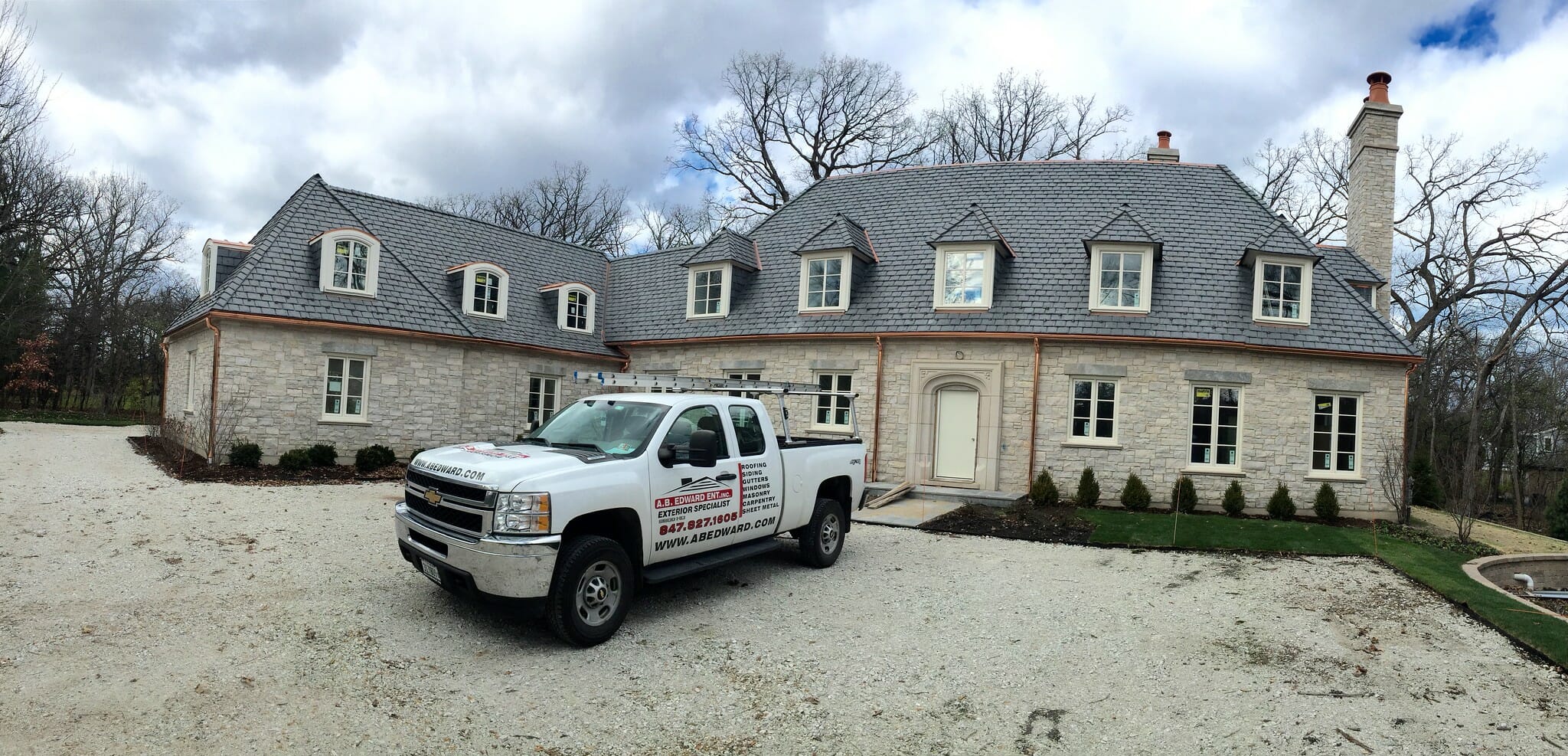All About Slate Roofs
Slate roofs are prized for their longevity, durability and distinctive look. When properly installed and well-maintained, these natural stone roofs can last 60 to 125 years depending on their maintenance and care. Their natural long lifespan and energy efficient insulating properties mean they can instantly add value to your home once installed.

Brief History of Slate Roofs
Historical accounts suggest that the first slate roof in Europe was installed in North Wales in 1287. The material was popular there due to the numerous veins of natural slate in the mountains. The practice of installing natural slate roofs continued for centuries and eventually came to America in Jamestown in 1650, Boston in 1634 and Philadelphia in 1699.
Any structures in the colonies with slate roofing installed were usually built with rock imported from North Wales, stated Jeffrey S Levine in his online article “The Repair, Replacement and Maintenance of Historic Slate Roofs.” Levine is the founder of Levine & Company, Inc. a roof consulting and architectural conservation firm. He is also a past president of the National Slate Association.
The first commercial slate quarry in the U.S. opened in 1785 in Peach Bottom Township in Pennsylvania. Historically, the busiest U.S. quarries were in Pennsylvania, Vermont and Virginia. By 1876, the nation was such a bustling producer of slate that it didn’t have to import it, wrote Joe Jenkins in “American Roofing Slate,” his illustrated online article.
Jenkins authored the highly regarded book the “Slate Roof Bible.” Though Maine, Maryland and New York also had quarries, he stated in his article that domestic slate today comes only from Vermont, Pennsylvania, Virginia and, to a lesser extent, New York.
Regions with Significant Slate Production
Vermont, most authorities agree, has the finest slate for roofing in the world, along with Pennsylvania. Spain also produces good quality slate. The odd geographical reason for this has to do with tectonic plate movement. Jenkins points out that before the continental drift long ago, Pennsylvania and Spain were adjacent to each other.
Slate in the U.S. today is sometimes imported from China. Other countries that have slate quarries for roofing and other purposes include India, Wales, France, and Portugal.

Advantages of Slate
Slate forms from shale, which is a sedimentary rock composed of silt and mud. When shale comes under pressure and combined with heat in the natural environment over a long period of time, it’s transformed into slate. The advantages of slate are:
- High resistance to fire
- Good capability for repelling water
- Physical properties allowing it to be cut into different sizes and thicknesses
- Variety of colors
- Ability to withstand freezing and rain
Since slate is a stone and lasts far longer than roofs made from other materials, it has a green footprint. It can also be recycled and used on other roofs.
Factors Affecting the Life of Slate Roofs
Quite a few historic buildings in the U.S. in the late 1800s and early 1900s had slate roofs. Some of those that had roofs of black slate from Pennsylvania only now have to be replaced. But the type of slate used is important as not all slate is the same. Generally speaking, black slate is usually soft slate and colored slate is usually hard slate, which is more durable.
Slate’s durability is affected by its mineral and physical qualities as it’s taken from the quarry and how it was cut, installed, and maintained. Even the location of the property affects the roof’s longevity. For instance, if one person’s roof gets a lot of sunlight and a neighbor’s gets less, the roof in the shady location or that’s better shielded from harsh elements will last longer.
Slate Roof Repair
If a few slates are missing or cracked, they can be replaced and the roof can be repaired. If 20 percent or more are damaged, it’s usually better to replace the whole roof. Property owners are advised to seek a contractor who has experience installing or repairing slate roofs and not undertake these repairs as the installation and handling of slate requires special training.
Some roofers will recommend replacing the roof with an asphalt shingle because they don’t know how to do work with roof tiles made of slate. If you find this when talking to contractors, move on to a slate expert instead. Slaters, or people who work on these roofs, know how to walk on them because they know that improper walking could end up breaking slates, and will restore your roof the way you want it, rather than sneaking in asphalt shingles and compromising the integrity of your roof.
Replacing a Roof and Its Cost
When considering slate tiles for new construction, homeowners must ensure that the structure can bear the heavier weight – slate is stone and weighs significantly more than asphalt shingles or cedar shake. If you already have a slate roof and need repairs make sure inspectors examine an existing roof to determine if it needs to be replaced, here are some of the conditions they should look for:
- Slates that can no longer repel water
- Wood sheathing that’s rotting
- Fallen slate than when tapped emits a dull sound rather than a clearer one
- Pieces of covering that break easily or have cracks or missing corners
Some property owners choose to replace their deteriorating slate roofing with one made of asphalt shingles. A prime reason is cost, as asphalt roofs cost about $1.50 to $4.00 per square whereas slate roofs cost about $9.00 to $14.00 per square. Sometimes beauty and durability take a back seat to the wallet and personal preferences.

Slate Roof Colors
Vermont is the source of slate roof tiles with the greatest number of colors beyond traditional black. They include green, gray black, purple, mottled green, sea green and red.
Shingles termed fading slates don’t actually change color. This slate over time develops a chalky substance that makes it appear to have faded. It’s this residue that makes the tiles appear to have faded. The variety called unfading doesn’t have the powdery dusting and usually maintains its original color. Typically, blue black and blue gray slates get the unfading nomenclature.
Weathering is something that happens to colored slates. It occurs after they’ve been exposed to the elements for a long period. Colors change to brown, buff, gray or tan. The amount of change depends on whether the property owner chooses weathering, semi-weathering or non-weathering slate. The non-weathering type exhibits the least amount of variation in color and weathering the most.
The designation natural weathering refers to what happens when a slate’s mineral impurities meet prolonged exposure to weather. Little bits of the slate’s outer layer flake and chip off. With even longer exposure to the elements, the inner layers cannot repel water.
Steep areas of a roof are less likely to suffer from this kind of weathering than others. Many times, roofs facing the south sustain more damage from rain, wind and sun than roofs fronting other directions.

Maintenance
Even when a roof is new, owners are advised to have it inspected after a few storms early in its life. Levine’s maintenance for historic roofs provides general guidelines for any slate roof. His tips are to:
- Clean gutters at least two times in the fall and once in early spring
- Replace broken slates quickly
- Have the roof inspected by a professional every 5 – 7 years
Anyone who’s ever seen natural slate roofing has witnessed a structure with a lot of history behind it, unless the roof is on a new home. These roofs may not exist in large numbers across the country, but some people and organizations recognize the importance of keeping them on historical structures. Some property owners choose them for their beauty as some of the patterns can be wild and colorful. Installing a slate roof will certainly have a positive impact on your home and its value and appearance, and A.B. Edward Enterprises can help you achieve the slate roof of your dreams!
Contact A.B. Edward Enterprises Today!
If you have a slate roof that needs repair or are considering installing a new slate roof, please feel free to contact us. We are happy to provide FREE ESTIMATES!
Here are a few more articles we are recommending for you.
- 7 Amazing Benefits of a Natural Slate Roof
- Environmental Benefits of Natural Slate Roofing
- Benefits Of Having A Natural Slate Roof
- Are You Searching for a Reliable Chicago Slate Roofing Company?

